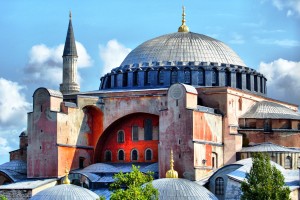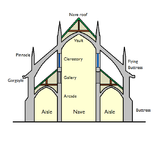My current topic of choice for this module was the buttresses for the Hagia Sophia. First off let me define what one is, thanks to my lovely sister and her masters degree in architecture, I will never forget what one is. A buttresses in its simplest terms is a sturdy wall a pillar or main section of a building can lean against or apply pressure to, to aid in its support. In the case of the Hagia Sophia there are four main buttresses and two semi-domes that effectively do the same thing. The buttresses work in tandem with the semi domes to apply pressure to keep the four main arches together. The main purpose for wanting the arches to stay in the designed shape is so it can support the main dome. If one of the arches were to sway slightly away the main dome would slip off of its fitting and crash. The reason for this to so easily happen is due to the dome sitting on the very edge of each of the four arches. Know that the arches are prone to sway based off of their design, the buttresses and semi domes act almost like a brink and mortar clamp to keep the Hagia Sophia together. Something else that struck my interest was with the modern restoration. the contractors have reverted back to the same brick and mortar method that was done with the main sections of the Hagia Sophia. The reason for reverting back to the older method and why it is beneficial, comes down to the method, the more mortar between bricks the more absorbent it will become. Resulting in the buttresses to become stronger and aid in preventing the main dome from collapsing.

Amazing photo of the jutting out buttresses and semi dome photo credit to Dave Spender
Sources:
https://en.wikipedia.org/wiki/Buttress
https://en.wikipedia.org/wiki/Hagia_Sophia


